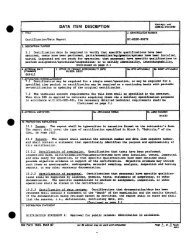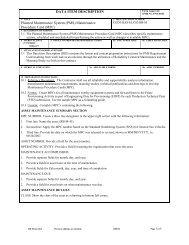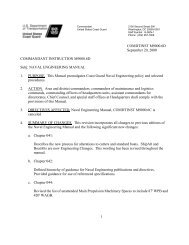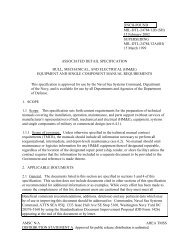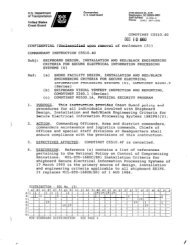comdtinst m2400.1f - US Coast Guard Response Boat-Medium
comdtinst m2400.1f - US Coast Guard Response Boat-Medium
comdtinst m2400.1f - US Coast Guard Response Boat-Medium
You also want an ePaper? Increase the reach of your titles
YUMPU automatically turns print PDFs into web optimized ePapers that Google loves.
ANNEX B - MARINE INFORMATION BROADCAST SCHEDULES (REFER NOTE AT END OF<br />
ANNEX B)<br />
Emissions: MF/HF (CW/100HA1A); 518 kHz (NAVTEX/304HF1B); 2-30 MHz<br />
(SITOR/300HF1B); 2-30 MHz (Voice/2K8J3E); 157.1 MHz<br />
(VOICE/16KF3E); (FAX/4KF3C) (NARROW BAND FAX/2K8F3C).<br />
500 kHz (100HA1A/1K03H2Z), 2183.4 (2182) kHz (2K8H3E/J3E),<br />
and 156.8 MHz (16KF3E) may be used to announce scheduled<br />
marine information broadcasts. These frequencies may also<br />
be used to transmit urgency and safety signals and<br />
urgency messages. Safety messages, whenever possible,<br />
should be transmitted on a working frequency assigned for<br />
broadcast purposes; however, transmissions of short<br />
safety messages on 2183.4 (2182) kHz and 156.8 MHz are<br />
permitted provided a certain situation warrants such<br />
action.<br />
Broadcasts of maritime safety information on Channel 22A<br />
(157.1 MHz), the ship station transmit frequency portion<br />
of International Channel 22, are not compatible with the<br />
international duplex arrangement of the channel (coast<br />
transmit 161.7 MHz, ship transmit 157.1 MHz). As a<br />
result, approximately 50% of foreign flag vessels<br />
in U.S. waters cannot receive <strong>Coast</strong> <strong>Guard</strong> maritime safety<br />
broadcasts on 157.1 MHz, even though these ships do carry<br />
VHF radios and do monitor Channel 16 (156.8 MHz).<br />
For additional information concerning marine broadcasts,<br />
refer to Chapter 13 of COMDTINST M16500.7 (Aids to<br />
Navigation manual), Chapter 14 of COMDTINST M2000.3 and/or<br />
instructions promulgated by the appropriate district<br />
commander. The shore stations that are designated to make<br />
scheduled broadcasts and their assigned working<br />
frequencies are as follows.<br />
The abbreviations listed under the subject column are as<br />
follows:<br />
WX - Scheduled weather broadcasts<br />
HD - Scheduled hydrographic information broadcasts<br />
NTM- Scheduled Notice to Mariners broadcasts<br />
! - Unscheduled warning broadcasts only<br />
# - The SSB carrier or dial frequency for the 2-3 MHz<br />
voice broadcast frequencies are located 1.4 kHz below<br />
the above assigned frequencies.<br />
B-2





